PEST MANAGEMENT
Root and pod feeders
- White grubs are serious pests of groundnut in north and north-east Gujarat, Rajasthan, Punjab, Haryana and Uttar Pradesh.
- In the southern states, their presence is restricted to sandy soils.
- They are polyphagous in nature.
Life cycle
The adults emerge from the pupae and hibernate in the soil till the following season. The adult beetles are 18–20 mm long and 7–9 mm wide. The fully grown grubs are stout with strong mandibles. |
 |
The head is yellowish and the body is 'C' shaped. They have three pairs of thoracic legs. The wrinkled portions of the body are dirty white in colour and the posterior smooth portion is brownish in colour. Egg laying begins after the summer rains.
The eggs are laid singly at a depth of 5–8 cm. A single female lays 20–80 eggs. The eggs are pearl-white and oval. The eggs hatch in 9–11 days.
The grubs, which hatch out of the eggs, are white, translucent and 5 mm long and they have three instars.
The grubs feed on the organic matter for a few weeks and then feed on the fine rootlets and pods. Pupation takes place in the soil where the insects remain as pupae until the following year. Mating takes place at the feeding sites.
After feeding, the adults reenter the soil to hide and lay their eggs. After the monsoon rains, the adults emerge from the soil. The adults are 18–20 mm long and 7–9 mm wide across the thorax.
Damage pattern
The grubs attack starts in the crop about one month after the mass emergence of beetles, i.e., after the first pre-monsoon or monsoon rain. The damage usually occurs in patches in the field. Grubs feed on the fine rootlets and nodules. This results in wilting and death.
Management
- Summer ploughing helps to bring out the larvae and pupae from the soil. Predatory birds can then feed on them.
- Seed treatment should be done with Solanum surattense extract.
- Early sowing helps the plants to escape from grub damage.
- Setting up light traps helps to monitor and collect the adult
beetles.
- The adults can be manually picked from the soil and
destroyed.
- Treat the kernels with kerosene (one litre per 70–80 kg
seeds) before sowing.
|
Termites (Odontotermes sp.)
Termites are polyphagous in nature. They are distributed in all groundnut growing areas in India. Termite infestation is severe in sandy and sandy loam soils.
Life cycle :
Termites are social insects that live in termitaria in distinct castes like workers, kings and queens. The queen lives for several years and lays several 1000 eggs during its lifetime.
Damage pattern :
The insects remain underground and feed on the roots. They penetrate and hollow out the tap root and cause wilting. This results in premature death of the plants. They bore into pods, damage the seeds and weaken the shells.
Management
- Harvesting the groundnut immediately after it matures and early removal of produce from the field reduces termite attack.
- Twigs of morning glory (Ipomoea fistulosa) can be used for the protection of pods from termites.
|
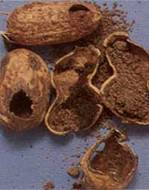 |
Earwig (Anisolabis stali)
The earwig is a main pest in south India, particularly in clayey soils. It also infests cabbage, cotton bolls and sorghum stems. Life cycle (56–72 days) Eggs are pearl white in colour and lie in clusters. The nymphs and adults look similar except for the forked abdominal tip in the nymphs. The females lay between 21–108 eggs. The eggs hatch in about a week. Nymphs pass through five instars.
Damage pattern
Both nymphs and adults bore into the pod and feed on the seeds. Infested pods are prone to fungal attack. |
Groundnut bruchid (Caryedon serratus)
This pest is found in Andhra Pradesh, Gujarat, Karnataka, Maharashtra and Tamil Nadu.
Life cycle
The adult beetles are brown in colour, measuring 4–7 mm long and 5 mm wide. They have a large hind leg. The eggs are translucent milky white in colour and are found attached to the pod walls.
Damage pattern
After hatching, the larva directly burrows into the pod wall and eats away the seeds. The first sign of attack is the appearance of 'windows' cut into the pod wall by the larva. After emerging from the pupal cocoon, the adults escape from the pod through these window cuts. When the infested pods are opened, silk and excreta can be seen on the seeds. The pupae are often found in large numbers at the bottom of the pile of sacks.The infested seed is unfit for human consumption or for oil expulsion. |
Jewel beetle (Sphenoptera indica)
The beetle is most common in south India during the rainy – and post rainy – season.
Life cycle
Adult beetles are shiny and dark brown in colour, measuring about 10 mm in length. The grubs are whitish with a globular head and with an elongated, dorsoventrally flattened body. They are also legless. The grubs grow up to 2.5 cm. The eggs are laid singly on the main stem.
Damage pattern
On hatching, the grubs burrow into the stem and tunnel into the roots causing the plant to wilt and die. When the infested plant is pulled out, grubs and pupae can be seen in its hollowed stem. |
Jassids (Empoasca kerri)
E. kerri is most common in Maharashtra, Gujarat and Tamilnadu. The pest outbreak is severe during August–September and February–March.
Life cycle
The adults are yellowish green with a flat vertex. The wings are long, narrow, semi-transparent and pale green in colour. The distal ends of the wings are slightly grayish. The nymphs are like adults but they are wingless. The eggs of the jassids are inserted into the leaf tissue close to the midrib. The eggs hatch out in about a week. Each female produces about 40 nymphs. The nymphs develop into adults in ten days.
Damage pattern
Both the nymphs and adults cause damage by sucking the sap from the central surface of the young leaves. As they suck, they inject toxins into the plant issue. This results in a whitening of the leaves and formation of 'V' shaped chlorotic patches at the tip of each leaflet. As the infestation gets more severe, the crop turns yellow and presents a scorched appearance known as 'hopper burn'.
Economic threshold level
Management measures should be implemented immediately if more than 10% of the leaves show characteristic 'hopper burn' symptoms.
Management
- Intercropping groundnut with lablab in a 4 : 1 ratio reduces the number of jassids on groundnut.
- Spray 1% neem leaf solution per hectare.
|
Thrips (Scirtothrips dorsalis, Thrips palmi, Frankliniella schutzei, Caliothrips indicus)
Thrips are polyphagous pests, soft-bodied, having highly fringed wings. They remain mostly in folded leaflets and flowers. Hence they are hardly noticed.
Life cycle
Thrips are 2 mm long and pale green in colour. The adults lay about 40–50 eggs which are inserted into the plant tissues. The nymphs pass through four instars before transforming into adults, a period which takes about fifteen days. The adults live for twenty days.
Damage pattern
The nymphs and adults lacerate the leaf surface and suck the oozing sap. This results in distortion of the leaflets and formation of white patches on their upper surfaces and necrotic patches on the lower. When the infestation gets severe, the plant remains stunted. Thrips transmit peanut bud necrosis.
Economic threshold level
Management measures should be implemented when five thrips are found per terminal leaf in a 30 day old crop.
Management
- Thrips damage can be avoided by early (first fortnight of June) sowing.
- Intercropping with sunflower reduces the thrips population.
|
Aphids (Aphis craccivora)
Aphids are cosmopolitan in distribution and at times cause severe infestation. They remain active throughout the year and peak incidence occurs during drought periods. Infestation by these insects is relatively higher in the rabi crop. They also occur in crops such as red gram, bengal gram, soybean, lucerne, black gram, green gram, peas and sesbania.
Life cycle
Aphids are small sized insects measuring 2 mm in length. They are pear shaped, greenish or greenish black in colour. The nymphs are dark brown and they turn into shiny black adults in about 10 days. Aphis craccivora reproduces without mating. The female adult occurs both in alate and apterous forms. The nymphs pass through four moults before they become adults. Each instar lasts for 1–2 days. Each female gives birth to 15–20 young ones. They mature in a week's time. Hence multiplication is faster. |
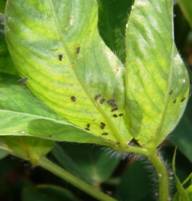 |
Damage pattern
Both the nymphs and adults suck the sap from the tender growing shoots and flowers. This results in distortion of the foliage and stems. Sooty moulds develop on their honey dew secretion. They transmit peanut stripe virus and the groundnut rosette virus complex.
- Release of parasites and predators such as coccinellids helps to control aphid populations.
- Release of aphid lion, Chrysoperla carnea grubs @ 3000/ha.
|
Red spider mite (Tetranychus cinnabarinus)
Red spider mites are minor pests of groundnut in India. The damage is severe in crops that grow under drought stress.
Life cycle : The adults lay eggs on the under surface of the leaves. The eggs hatch in 3–5 days. The life cycle is completed in 15 days.
Damage pattern
Nymphs and adults suck the sap from the under surface of the leaves. The infested leaves show yellowing and finally turn white. Fine webbings appear on the under surface of the leaves. The tips of the plants appear reddish due to the presence of a large number of mites. Ultimately the whole plant withers and dies. The infestation appears in patches and slowly spreads to the unaffected crop. Dissemination of mites is mainly through human disturbance and wind. |
Red hairy caterpillar (Amsacta albistriga, A. moorei)
There are two species of red-headed hairy caterpillars. A. moorei is dominant in northern states while Amsacta albistriga is the most dangerous pest of groundnut in south India. It is very destructive. Besides groundnut, it also attacks chickpea, sorghum, cotton, castor and maize.
Life cycle
The adult moths are brownish white in colour with distinct orange bands on the abdomen. Both the forewings and hind wings are whitish in colour. The forewings have brownish streaks all over and an orange line along the margin. Distinct black spots can be seen on the hind wings. The adult moths emerge from the soil immediately after the monsoon rain. Each female lays about 700–1000 eggs in clusters in 2–6 days. They lay the eggs on the under surface of the leaves. The egg clusters are also found on soil clods and on dry leaves and twigs. The eggs are yellowish and shiny and hatch in 2–3 days. The larvae remain in clusters on the under surface of the leaves and feed on the chlorophyll content of the leaves. The young larvae are brownish and without hair. In about 40–50 days they turn into matured larvae. Mature larvae are highly active and destructive. They are reddish brown in colour and have dense hair all over the body. |
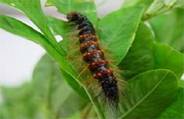
|
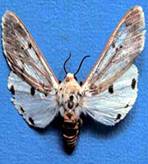 |
These larvae burrow into the soil and remain as pupae for about 10–12 months to emerge again when the next monsoon showers arrive.
Damage pattern
The larvae eat away the leaves leaving behind the midrib, the veins and the petiole. The infested leaves appear as if grazed by cattle. They move in clusters from one field to the other and cause infestation. The yield obtained from the infested crop is considerably reduced.
Economic threshold level
The ETL for red-headed hairy caterpillar is eight egg masses per 100 m of crop length or 10% leaf damage.
Management
- Nuclear polyhedrosis virus (NPV) spray is effective in controlling the larvae when they are young.
- Egg parasitoids – Telenomous manolus is effective in destroying the eggs.
- Fungal parasitoids – Aspergillus flavus effectively controls the larvae.
- Lighting a fire near the field during the night-time helps to get rid of red hairy caterpillars as well.
- Adopt summer ploughing. • In certain places, farmers chase away the caterpillars from
the field by blowing a sangu (conch). Farmers start blowing the sangu from the three corners of the field. It is believed that the caterpillars congregate and try to escape through the fourth corner where they can be collected manually and destroyed.
- In rain-fed groundnut, raise one row of cowpea for every five rows of groundnut. Crops such as pigeon pea, black gram, sunflower, sesame, pearl millet or other pulses are intercropped with groundnut. Mix lemon (150 ml) and tamarind juice (150 ml) in 15 litres of water. Apply this solution thrice for effective control.
|
Groundnut leaf miner (Aproaerema modicella)
This pest is found especially in south India. Besides cotton, it also infests soybean and legumes. Life cycle The adult moth is brownish grey in colour, measuring 6 mm in length. The wings are highly fringed. The young larvae are shiny, black headed and greenish in colour measuring about 5–6 mm in length. The female adult lays eggs singly on the leaf surface close to the midrib. Each female lays about 200 eggs. In 3–4 days, young larvae hatch out of the eggs. In two weeks, the larvae mature and turn greenish. They remain inside the leaf folds and turn into pupae. The pupal stage lasts for 4–5 days. The adult moths which emerge from these pupae are small and blackish in colour. A prominent white spot is found on the forewings.
Damage pattern
The young larvae which hatch out of the eggs bore into the leaflets and feed on the mesophyll tissue of the leaves. As a result, small, brown blotches appear on the leaves. At later stages, the larvae web the leaflets together, remain inside the web and continue to feed on the leaf tissues. When the infestation gets severe, the leaves lose their shape and the plant remains stunted. A severely attacked crop presents a burnt appearance.
Economic threshold level
Management measures should be implemented immediately when the insect crosses the economic threshold level of one larva per metre.
Management
- In rain-fed groundnut, early sowing reduces pest incidence.
- Light traps can be set up to monitor and trap the adults.
- Pheromone traps can be set up in the field as well.
- Groundnut can be intercropped with soybean, pearl millet or lablab in 1 : 4 ratios. • Mulching in dry lands helps to reduce leaf miner incidence.
- Spray neem seed kernel extract (15 kg/ha) or neem oil (15
litres /ha) or neem leaf extract (25 kg/ha).
- The field is first flooded to submerge the crop overnight and
drained the following morning. This is a common practice among the farmers of the Tungabhadra area of Karnataka.
|
Tobacco caterpillar (Spodoptera litura)
Tobacco caterpillar infestation is severe in the fields of Karnataka, coastal areas of Andhra Pradesh and Tamil Nadu. The activity occurs during the post rainy season.
Life cycle
The young larva is light green in colour. The later instars are dark with a prominent black spot on the thorax. The fully-grown caterpillars are stout, velvety, cylindrical and pale greenish brown in colour. They have a lateral series of spots, which are purplish black in colour. The yellow coloured sub marginal series of spots have black lunules above them. The adults are stout and medium sized moths. |
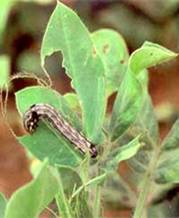 |
The forewings are greyish brown in colour with wavy white markings. The hind wings are opalescent and semi-hyaline white in colour with a dark brown marginal line. Each female adult lays several hundreds of eggs in clusters on the upper surface of the leaves which are covered by brownish yellow hairs. In 2–3 days, the eggs hatch and the larvae disperse quickly. Initially light green in colour, the larvae turn dark on maturity. They pupate in the soil. The pupae are reddish brown in colour and are found close to the plants.
Damage pattern
The newly hatched larvae feed gregariously on the chlorophyll tissue of the leaves. Scratch marks can be seen on the infested parts of the leaves. At later stages, the larvae hide on the under surface of the leaves and feed on the leaf tissues at night. At times the infestation is so severe that only the petioles and branches are left behind. After infestation, the larvae migrate in groups from one plant to another.
Economic threshold level
The ETL for the pest is eight egg masses per every 100 m of crop length or 10% leaf damage.
Management
- Set up a light or pheromone trap @ 5 per acre
- Castor should be grown as a trap crop along with groundnut.
- The egg masses should be collected manually and destroyed.
- Digging trenches around the infested fields prevents the migration of larvae.
- Application of nuclear polyhedrosis virus (NPV) @ 250 LE/ha with crude sugar 2.5 kg/ha in the evening hours is effective.
|
Gram caterpillar (Helicoverpa armigera)
The gram caterpillar is a polyphagous pest distributed throughout India. The infestation is high in south India. Life cycle The eggs are yellowish white in colour. The caterpillars are of varied colours, mostly dark greenish brown or apple green. They have whitish or dark grey longitudinal lines with white stripes on the lateral side. The adult moths are medium sized, stout and pale brownish in colour. The forewings are pale brown in colour. They have indistinct wavy lines along the margin with a dark brown spot in the centre. The hind wings are smoky white in colour with a blackish outer border. The pest completes about four generations in a year. Eggs are yellowish-white in colour and dome-shaped and are laid in leaf buds of groundnut and hatch in 2–5 days. The larvae pass through six instar stages. When the larvae are fully grown, they burrow into the soil to a depth of 2–18 cm for pupation. The pupae are smooth, 14–18 mm long. The pupal period lasts for 5–8 days. |
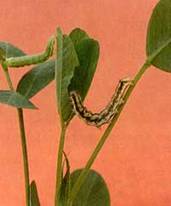 |
Damage pattern
The larvae feed on the foliage. When the tender leaf buds are infested, symmetrical holes or cuttings are seen when the leaves are unfolded. Economic threshold level
10% leaf damage
Management
- Growing sunflower as a border or intercrop in groundnut helps to trap Helicoverpa.
- Monitor the emergence of adult moths by setting up light or pheromone traps (five per acre).
- Avoid monocropping.
- Optimise use of nitrogenous fertilizers • Avoid migration of larvae by digging a trench 30 cm deep
and 25 cm wide with perpendicular sides around the infested
fields.
- Application of nuclear polyhedrosis virus (NPV) @ 250 LE/ha with crude sugar (2.5 kg/ha) in the evening hours is effective. Grow castor as a trap crop.
- Do crop rotation with sorghum, maize, bajra and sugarcane • Release of Trichogramma egg parasitoids @ 7.5 cc/ha.
- Dilute 200 ml of Prosopis leaf extract with ten litres of water and spray.
- Set up bird perches.
|
| Beneficial insects : Pentatomid bugs, syrphids, ladybird beetles, lace wings, Apanteles sp. |
Source : Centre for Indian Knowledge Systems, Chennai
Updated on : Dec 2014 |

